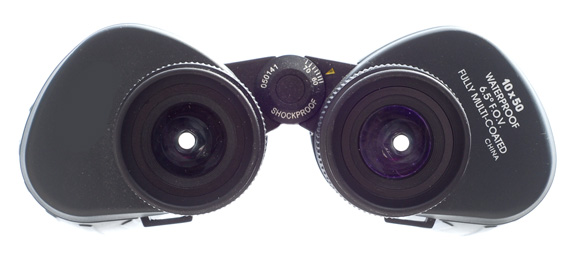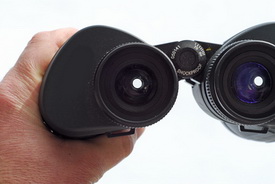
One binocular specification that seems to generate more than its share of contradictory advice is exit-pupil size. I’ve often seen statements to the effect that you should avoid binoculars with smaller exit pupils because the view is “dimmer” than in models having larger exit pupils. But is this actually true, and more importantly, should it factor into your binocular selection?
The first thing you’re probably wondering though is what the heck is an exit pupil? That’s the easy part. Take a pair of binoculars and hold them at arms length. See the disks of light that seem to lie on the surfaces of the eyepieces? Those are exit pupils. Their size is determined by the binocular’s magnification and the diameter of the front lenses. You can measure exit-pupil size with a ruler, but it’s easier to use some basic math. Simply divide the aperture by the magnification. For example, 10×50 binoculars will have 5 millimeter exit pupils (50 ÷ 10 = 5). As you can see, exit-pupil diameter and magnification are related — for a given binocular size, higher magnification produces smaller exit pupils. When we talk about binoculars with smaller exit pupils, what we’re really discussing is binoculars with higher magnification.

So does higher magnification really mean a dimmer image? Let’s look at a specific example: the Andromeda Galaxy, M31. For an extended object, such as a galaxy or nebula (as opposed to stars), no binocular will make the object brighter. This is where most people go, “huh?!” It’s true. Yet binoculars will make M31 easier to see. That sounds like a contradiction until you understand how binoculars (or telescopes, for that matter) work their magic.
Magnification Matters
The reason M31 is easier to see in binoculars than with your naked eye is magnification. Simply put, the magnifying power of binoculars makes the galaxy appear larger to your eye. Within reason, the more magnification you apply, the bigger M31 will look, and the easier it will be to see. This is why 10×50s will show the galaxy more plainly than 7×50 binoculars even though they have smaller exit pupils.
But wait, doesn’t higher magnification dim the background sky? You bet. In fact, one reason many observers avoid binoculars with big exit pupils is because they show the sky background at its maximum brightness. But here’s the thing: when we go with higher magnification, both the the background sky and the galaxy are dimmed by the same amount. To put it another way, the contrast between the sky and the galaxy remains the same. However, it’s true that the combination of larger image scale and a darker background sky gives the illusion of improved contrast, even if the brightness of the galaxy relative to the background sky is unchanged.

Not everything we look at in our binoculars is an extended object though. When we talk about point sources of light (stars), different rules apply. Here there’s a real contrast improvement when we choose binoculars with greater magnification (and therefore, smaller exit pupils). Higher magnification binos produce a dimmer background sky, but the brightness of stars is fixed by the size of the objective lenses. In other words, there’s a bit of a free lunch where stars are concerned — increased magnification dims the background sky, but not the stars. Because of this contrast boost, fainter stars become easier to see as the magnification goes up.
Why are stars so special? Simply because no amount of magnification will make them appear bigger — all their light remains tightly concentrated into a tiny point. But when we magnify M31, its apparent size increases and its light is spread out to cover a larger area.
Smaller is Better
If you combine all the effects described above, you can see why smaller exit pupils produce noticeably better views. The resulting darker background sky improves the contrast for stars and the overall aesthetics of the image, while the larger apparent size of extended targets makes them easier to see. It’s worth remembering that all this applies to telescopes exactly the same way. And yet you don’t hear anyone saying “avoid small exit pupils with your telescope because it makes the view dim!”
None of this is to say that low-power (big exit-pupil) binoculars are bad news, it’s simply a matter of deciding what you’re after. Low power typically means wider fields of view, and if that’s more important to you than seeing detail in your targets, then your choice would be different.
As Tele Vue founder Al Nagler summarized in his May 1991 article in Sky & Telescope, “The bottom line for low power is to frame the subject. In fact, the best view occurs with the highest power that comfortably includes the target object . . . higher powers darken the background sky, reveal fainter stars, and show more detail.”
So the short answer to our question is yes, smaller exit pupils produce a dimmer image. But since the visibility of the objects we want to see are improved, this is largely a pointless way to look at the situation. In many respects, the whole notion of choosing binoculars based on exit-pupil size is taking hold of the wrong end of the stick. If you make your decision using the parameters described in this article , you’ll do fine.
Did you find this article interesting or helpful? If so, consider using this link the next time you shop at Amazon.com. Better yet, bookmark it for future use. Thanks to Amazon’s associates program, doing so costs you nothing yet helps keep this site up and running. Thanks!
